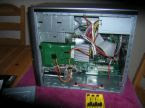
When you are ready to begin installing your new DVDDrive,have plenty of roon on your desk or table towork.Allow enough space to move around and to beable to move the system unit as well.
Check to see if you have ample light.You may want tohave a container to place small screws in.The systemunit cover may have small screws and you don't wantto lose them.
After you have plenty of work space and ample lighting,prepare your mind as well.Make this and every otheradventure of working on your computer educationaland fun.
Now go over to www.ultimatepcrepair.com/photos.htmlto familarize yourself with all components inside the PC.Take the time to study the actual components insideyour computer.You'll be glad you did should somethinggo wrong.Follow these steps to install your drive.
REMOVE THE COMPUTER COVER
First Turn off your computer and unplug all peripherals.Take notice of how you unplug or disconnect anydevices.
Second Remove the side panel of the tower system or the cover if you have a desktop.Place the panel in asafe place well out of the way.
Third Before touching anything inside the system unit,remove electrical static charge from your body bytouching a door knob or any unpainted metal surface.
Fourth Remove the new drive from its protective wrapping and take the time to read through the manual.Be sure you have all components and save the boxjust in case it need to be returned.
Fifth Check the jumper settings on the drive to be sureit is set to master.If you are adding this drive as a seconddrive,you will have to set one as master and one as theslave drive.
Your manual should make this procedure quick and fast.A small pair of tweezers can be used to remove thesmall jumper to the correct position.Most drives are setto master by default.
SLIDE NEW DRIVE IN COMPUTER
Sixth Locate the drive bay for the cdrom drive.In mostcases,its at the top of the case.If you are removinganother drive,slide it out partially,disconnect cables,and slide the drive out completely.Take note of thelocation of all connections.
If you are installing a new drive the first time,use asmall screwdriver to pop off the 5.25 inch drive baycover and bezel on the system unit case.
Seventh Slide the new drive in partially and connectthe data,sound,and power cables to the rear of thedrive.Slide the drive in completely and use smallscrews to secure the drive to the case.
In some cases,the drive is secured to the case with theuse of Drive rails.These rails should be mounted onthe old drive if you had to remove one.Check the drive'smanual if your new drive came with side rails.
When connecting the cable,carefully graps the cablesby the ends and not the wires themselves.Carefullybut firmly push the connectors into their sockets untilyou are certain of a good connection.
If you are installing this drive as a second drive andhave made this drive the secondary or slave drive,connect the drive to the center connector on the Ribbon cable.The master drive must be at the end.
Eighth After all cables are re-connected to the drive andthe drive is secured to the case,replace the system unitcover,reconnect all peripherals.Be sure the faceplate ofthe drive is flush with the front of the computer.
SETUP YOUR NEW DVD DRIVE
Ninth Boot up the computer and in nearly all cases,theoperating system should detect the new drive and install the device driver if necessary.
In most cases,new cdroms and dvd drives will notcome with a cdrom or diskette with a device driver.Windows should install the drive with ease.
Some new drives will come with a cdrom full of software,such as games,music,or movies.Checkthis cdrom for software utilities that you may needto help run and operate your drive.
Tenth Check your new drive to see if Windows hasrecognized it.Click on My Computer and you shouldsee the drives installed.Check for both drives if youinstalled the drive as a second drive.
And that's it.You can now use the drive as a huge data backup.Or you may want to make movies.Whatever the case,check the drive for compatbilitywith other drives.
Take the time to learn absolutely everything aboutthat computer you're reading this with.Quicklymaster the art of installing not just the dvd drive,but all drives and other components.











